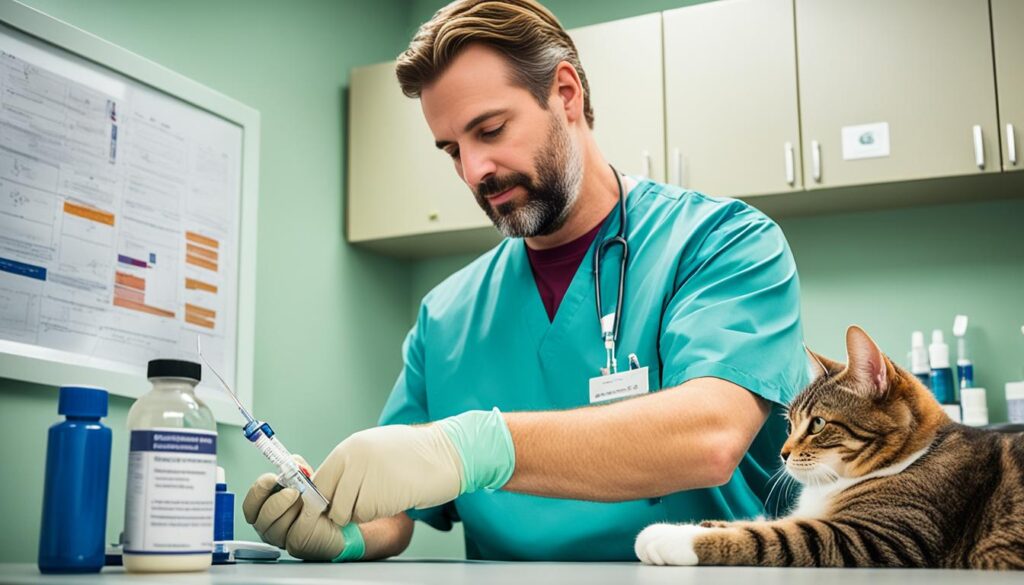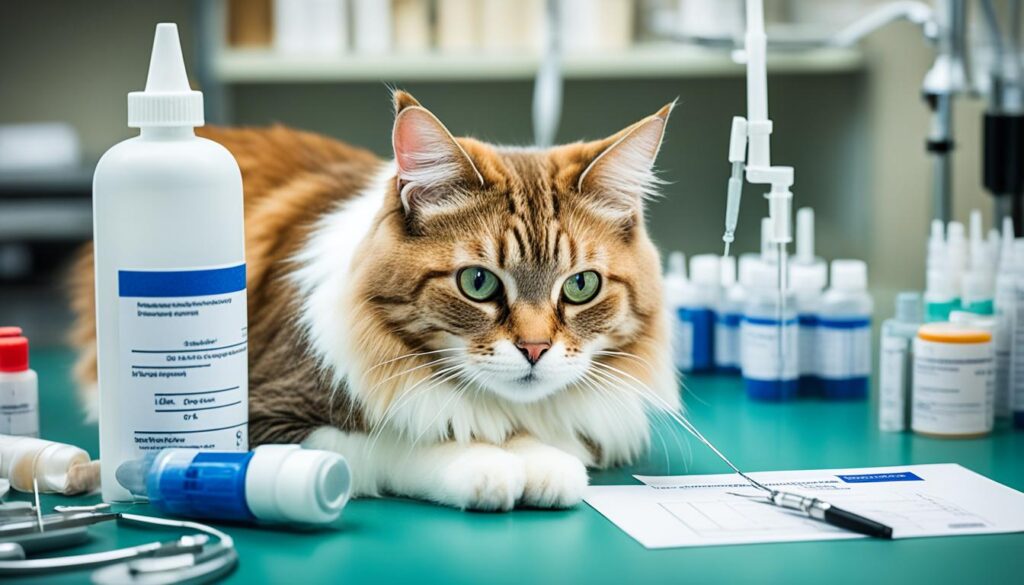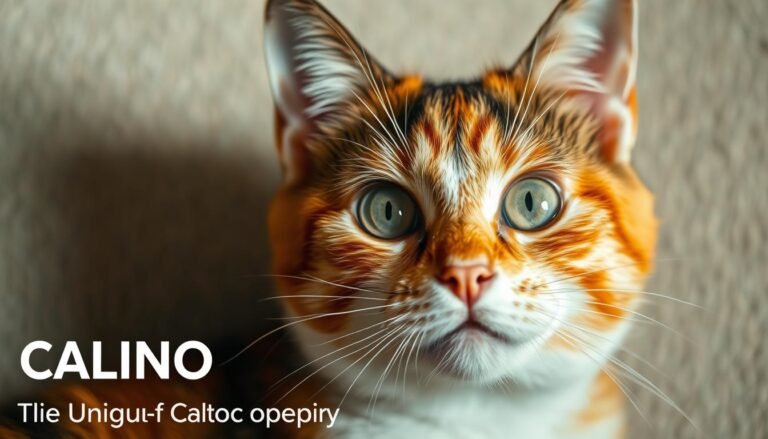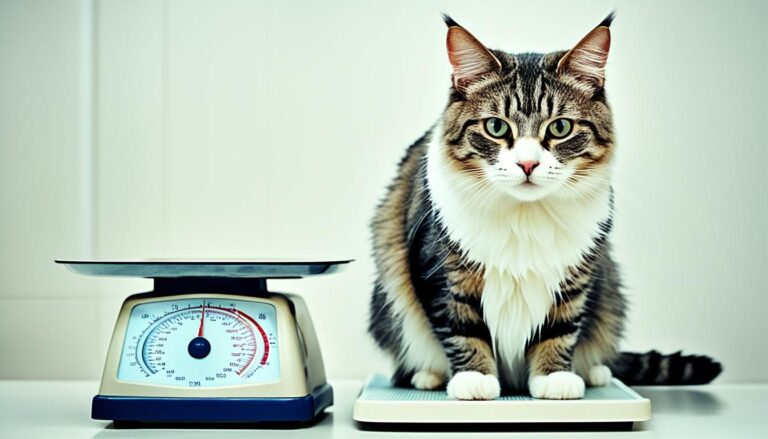What Glucose Level Is Too Low For Cats?- Key Takeaways:
- Hypoglycemia is a dangerous condition for cats and can lead to unconsciousness and death if left untreated.
- Cats undergoing treatment for diabetes are at a higher risk for hypoglycemia, especially due to insulin administration.
- Symptoms of hypoglycemia in cats include weakness, lethargy, vomiting, blindness, lack of coordination, anxiety, seizures, coma, and death.
- Several factors can contribute to hypoglycemia in cats, such as insulin overdose, missed meals, changes in diet or insulin administration, infection or illness, hormonal disease, and medication interactions.
- Treatment involves raising blood glucose levels and investigating the underlying cause. Pet parents of cats with diabetes should be prepared to manage hypoglycemia.
Causes and Risk Factors of Hypoglycemia in Cats
Several factors can contribute to hypoglycemia in cats. Cats undergoing treatment for diabetes are at a higher risk, especially if there are mistakes made in insulin administration, such as giving too much insulin, using the wrong needle and syringe, or missing or delaying meals. Changes in diet, the amount of food fed, or the time of insulin administration can also trigger hypoglycemia. Other causes include infection or illness, decreased appetite or vomiting, changes in the body’s need for insulin, concurrent hormonal disease, interaction of insulin with other medications, increase in activity, heatstroke, liver disease, kidney disease, and remission of diabetes. It is important for cat owners to be aware of the symptoms of hypoglycemia in cats and to seek immediate veterinary care if they suspect low blood glucose levels. Monitoring blood sugar levels and being consistent with feeding times, insulin administration near mealtime, diet, exercise, and routine bloodwork are ways to decrease the risk of hypoglycemia in cats.Symptoms of Hypoglycemia in Cats
- Weakness
- Lethargy
- Vomiting
- Blindness
- Lack of coordination
- Anxiety or restlessness
- Seizures
- Coma
Treating Hypoglycemia in Cats
When treating low glucose levels in cats, prompt intervention is crucial. If hypoglycemia is suspected, immediate oral administration of glucose solution or corn syrup is recommended. Rubbing a small amount of glucose solution or corn syrup onto the cat’s gums or under its tongue is preferable in severe cases. In more severe cases, intravenous dextrose solution may be necessary. It is important for pet owners to be prepared for these emergencies by having a source of glucose readily available.| Possible Causes of Hypoglycemia in Cats | Risk Factors |
|---|---|
| Insulin overdose | Cats undergoing treatment for diabetes |
| Missed meals or delayed meals | Changes in diet or insulin administration |
| Infection or illness | Decreased appetite or vomiting |
| Changes in the body’s need for insulin | Concurrent hormonal disease |
| Interaction of insulin with other medications | Increase in activity or heatstroke |
| Liver disease or kidney disease | Remission of diabetes |
Diagnosis of Hypoglycemia in Cats
 Hypoglycemia in cats can be easily diagnosed in a hospital setting through a blood glucose level check. A lower-than-normal blood glucose level, in combination with the cat’s history and clinical signs, can confirm the diagnosis. To determine the underlying cause of the hypoglycemia, additional tests may be performed.
Blood chemistry profile: This test assesses the health and function of the liver, kidneys, and pancreas.
Complete blood count: It helps identify abnormal red and white blood cell counts and patterns.
Urinalysis: It evaluates kidney function and checks for urinary tract infection.
Cortisol test: It reveals abnormalities in the body’s stress hormone.
Thyroid test: It evaluates the amount of thyroid hormone.
Imaging studies: X-rays and ultrasounds can check for tumors, abscesses, infections, liver shunts, and liver abnormalities.
It is important to diagnose and treat hypoglycemia in cats promptly to prevent potential complications and further deterioration of the cat’s condition.
Hypoglycemia in cats can be easily diagnosed in a hospital setting through a blood glucose level check. A lower-than-normal blood glucose level, in combination with the cat’s history and clinical signs, can confirm the diagnosis. To determine the underlying cause of the hypoglycemia, additional tests may be performed.
Blood chemistry profile: This test assesses the health and function of the liver, kidneys, and pancreas.
Complete blood count: It helps identify abnormal red and white blood cell counts and patterns.
Urinalysis: It evaluates kidney function and checks for urinary tract infection.
Cortisol test: It reveals abnormalities in the body’s stress hormone.
Thyroid test: It evaluates the amount of thyroid hormone.
Imaging studies: X-rays and ultrasounds can check for tumors, abscesses, infections, liver shunts, and liver abnormalities.
It is important to diagnose and treat hypoglycemia in cats promptly to prevent potential complications and further deterioration of the cat’s condition.
Diagnostic Tests for Hypoglycemia in Cats
| Test | Purpose |
|---|---|
| Blood glucose level check | To confirm hypoglycemia |
| Blood chemistry profile | To assess liver, kidney, and pancreas health |
| Complete blood count | To identify abnormal blood cell counts |
| Urinalysis | To evaluate kidney function and check for urinary tract infection |
| Cortisol test | To reveal abnormalities in the body’s stress hormone |
| Thyroid test | To evaluate thyroid hormone levels |
| Imaging studies (X-rays and ultrasounds) | To check for tumors, abscesses, infections, liver shunts, and liver abnormalities |
Treatment of Hypoglycemia in Cats
 Treatment for feline hypoglycemia focuses on raising low blood glucose levels in cats. Depending on the severity of the condition, different treatment options may be employed.
Oral Treatment: For mild cases of hypoglycemia, applying Karo corn syrup or honey to the gums can be an effective way to raise blood glucose levels. These oral options can be administered at home or in a hospital setting.
Intravenous Administration: If the cat’s blood glucose levels are very low or they do not respond to oral treatment, intravenous administration of glucose may be necessary. This involves delivering glucose directly into the bloodstream for rapid and effective absorption. Intravenous dextrose solution, in particular, is more commonly used in severe cases of hypoglycemia.
Supportive Care: Cats with severe hypoglycemia may require additional supportive care. This includes providing appropriate nutrition and warmth to help stabilize their condition.
Treatment of Seizures: In some cases, hypoglycemia can lead to seizures. To address this, anticonvulsant medication may be administered to control and manage seizures effectively.
Investigating the Underlying Cause: Once the cat’s condition is stable, further investigation may be necessary to determine the underlying cause of hypoglycemia. This may involve additional diagnostic tests, such as blood chemistry profiles, complete blood counts, and imaging studies, to identify any other potential factors contributing to the low blood glucose levels.
Managing Hypoglycemia in Cats with Diabetes: It is important for pet parents to be prepared to manage hypoglycemia in cats with diabetes. This involves having a source of glucose, such as corn syrup or honey, readily available in case of emergencies. Regular monitoring of blood glucose levels using a blood glucose monitor is also crucial for early detection and effective management of hypoglycemia in cats. Following the recommended guidelines for insulin administration, feeding, and routine check-ups with a veterinarian can help prevent and manage hypoglycemia in cats.
Treatment for feline hypoglycemia focuses on raising low blood glucose levels in cats. Depending on the severity of the condition, different treatment options may be employed.
Oral Treatment: For mild cases of hypoglycemia, applying Karo corn syrup or honey to the gums can be an effective way to raise blood glucose levels. These oral options can be administered at home or in a hospital setting.
Intravenous Administration: If the cat’s blood glucose levels are very low or they do not respond to oral treatment, intravenous administration of glucose may be necessary. This involves delivering glucose directly into the bloodstream for rapid and effective absorption. Intravenous dextrose solution, in particular, is more commonly used in severe cases of hypoglycemia.
Supportive Care: Cats with severe hypoglycemia may require additional supportive care. This includes providing appropriate nutrition and warmth to help stabilize their condition.
Treatment of Seizures: In some cases, hypoglycemia can lead to seizures. To address this, anticonvulsant medication may be administered to control and manage seizures effectively.
Investigating the Underlying Cause: Once the cat’s condition is stable, further investigation may be necessary to determine the underlying cause of hypoglycemia. This may involve additional diagnostic tests, such as blood chemistry profiles, complete blood counts, and imaging studies, to identify any other potential factors contributing to the low blood glucose levels.
Managing Hypoglycemia in Cats with Diabetes: It is important for pet parents to be prepared to manage hypoglycemia in cats with diabetes. This involves having a source of glucose, such as corn syrup or honey, readily available in case of emergencies. Regular monitoring of blood glucose levels using a blood glucose monitor is also crucial for early detection and effective management of hypoglycemia in cats. Following the recommended guidelines for insulin administration, feeding, and routine check-ups with a veterinarian can help prevent and manage hypoglycemia in cats.
| Treatment Options | Benefits | Considerations |
|---|---|---|
| Oral Treatment (Karo corn syrup or honey) | Convenient and can be administered at home | May not be effective for severe cases of hypoglycemia |
| Intravenous Administration of Glucose | Rapid and effective absorption of glucose | Requires veterinary expertise and equipment |
| Supportive Care | Helps stabilize the cat’s condition | Should be given under veterinary guidance |
| Treatment of Seizures | Controls and manages seizures associated with hypoglycemia | Requires appropriate medication and veterinary supervision |
| Investigating the Underlying Cause | Identifies any other contributing factors to hypoglycemia | Additional diagnostic tests and procedures may be required |
Recovery and Management of Hypoglycemia in Cats
With prompt treatment, the clinical signs and symptoms of hypoglycemia in cats should improve within minutes. In cases of a large insulin overdose, repeated treatments may be needed to counteract the long-lasting action of insulin. Cats may need to be kept in the hospital for continuous infusion of glucose in severe cases. Pet parents of cats with diabetes should be prepared to manage hypoglycemia by having a source of glucose and a blood glucose monitor readily available. After the administration of glucose, small amounts of food should be offered every 1-2 hours until the effects of the insulin overdose have been counteracted. Consistency in feeding times, insulin administration near mealtime, and routine blood glucose monitoring are crucial for managing hypoglycemia and preventing its recurrence. Regular communication with a veterinarian and follow-up visits are important for the long-term management of hypoglycemia in cats. For a comprehensive overview of the recovery and management of hypoglycemia in cats, please refer to the following table:| Treatment | Description |
|---|---|
| Administration of glucose | Oral or intravenous options to raise blood glucose levels |
| Supportive care | Providing appropriate nutrition and warmth |
| Investigating the cause | Identifying underlying factors contributing to hypoglycemia |
| Blood glucose monitoring | Regular monitoring to prevent recurrence of hypoglycemia |
Glucose Toxicity and Hypoglycemia in Cats
Glucose toxicity can be a significant concern when insulin secretion is reduced as a result of prolonged hyperglycemia in cats. The extended and high-dose therapeutic use of glucocorticosteroids or exogenous progestogens may lead to prolonged hyperglycemia and diabetes mellitus, making cats more susceptible to hypoglycemia. Hypoglycemia in cats can be triggered by factors such as excessive insulin dosage, overlapping insulin administration, reduced appetite, vomiting, and excessive exercise. It is important for cat owners to be mindful of these factors and to closely observe any abnormal behaviors that may indicate hypoglycemia in their cats. Prompt intervention and treatment are critical in preventing complications and ensuring the overall well-being of the cat.Recognizing the Signs of Hypoglycemia in Cats
Recognizing the signs of hypoglycemia in cats is essential for early intervention and treatment. If left untreated, low blood sugar levels can lead to serious complications and even be life-threatening for our feline companions. It is crucial for cat owners to be aware of the potential dangers of low blood sugar in cats and be able to identify the symptoms of hypoglycemia. The signs of hypoglycemia in cats may vary in severity and can manifest in different ways. Early on, you may notice your cat displaying signs of increased hunger, restlessness, shivering, or incoordination. As the condition progresses, more severe symptoms may develop, including disorientation, convulsions, seizures, and even coma. It is important to note that the early signs of hypoglycemia in cats can be subtle and easily overlooked. Some cats may become unusually quiet and lose their appetite when experiencing low blood sugar levels. Therefore, it is crucial to pay close attention to any abnormal behaviors or changes in your cat’s usual routine that could be indicative of hypoglycemia. If you suspect that your cat may be experiencing low blood sugar, it is essential to seek veterinary attention promptly. Hypoglycemia requires immediate intervention and treatment to prevent further complications and ensure your cat’s well-being. By recognizing the signs of hypoglycemia and acting quickly, you can help prevent the progression of the condition and its potential dangers. Veterinary care, proper management, and adherence to recommended treatment plans are paramount in ensuring the health and safety of your beloved feline companion.Summary of Hypoglycemia Symptoms in Cats:
- Increased hunger
- Restlessness
- Shivering
- Incoordination
- Disorientation
- Convulsions
- Seizures
- Coma
- Unusual quietness
- Loss of appetite
Emergency Treatment for Hypoglycemia in Cats
In cases of suspected hypoglycemia in cats, immediate oral administration of glucose solution or corn syrup is recommended, with a dosage of 1g per kg of body weight. Care should be taken not to force large volumes of fluid into the mouth of a collapsed cat to avoid the risk of aspiration pneumonia. Rubbing a small amount of glucose solution or corn syrup onto the cat’s gums or under its tongue is preferable in such cases. Intravenous dextrose solution can be administered if oral therapy is ineffective or in severe cases. It is important for pet owners to be prepared for such emergencies by having a source of glucose readily available. Following the emergency administration of oral glucose, small amounts of food should be offered at regular intervals until the effects of the insulin overdose have been counteracted. Regular monitoring of blood glucose levels and adjustment of insulin dosage may be necessary to prevent future episodes of hypoglycemia.Conclusion
Hypoglycemia in cats is a serious condition that requires immediate attention and treatment. Recognizing the symptoms and seeking veterinary care promptly is essential for the well-being of your cat. For pet parents of cats with diabetes, it is crucial to be well-prepared to manage and prevent hypoglycemia. Following the recommended guidelines for insulin administration, regular monitoring of blood glucose levels, and maintaining a consistent feeding schedule can help prevent low glucose levels in cats. Regular communication with your veterinarian is important for the long-term management of hypoglycemia in cats. Working together, you can develop a comprehensive treatment plan and make any necessary adjustments to ensure your cat’s glucose levels are stable and well-controlled. By understanding the risks and taking proactive measures, cat owners can help safeguard their pets‘ health and ensure a better quality of life. With proper management and care, cats with hypoglycemia can lead happy and healthy lives.FAQ
What are the symptoms of hypoglycemia in cats?
The symptoms of hypoglycemia in cats include weakness, lethargy, vomiting, blindness, lack of coordination, anxiety, seizures, coma, and eventually death.
What factors can contribute to hypoglycemia in cats?
Several factors can contribute to hypoglycemia in cats, including insulin overdose, missed meals, changes in diet or insulin administration, infection or illness, hormonal disease, and interactions with other medications or increased activity.
How is hypoglycemia in cats diagnosed?
Hypoglycemia in cats can be diagnosed through a blood glucose test, and additional tests such as blood chemistry profile, complete blood count, urinalysis, cortisol test, thyroid test, and imaging may be necessary to determine the underlying cause.
What is the treatment for hypoglycemia in cats?
Treatment for hypoglycemia in cats involves raising blood glucose levels through oral or intravenous options, providing supportive care, and investigating the cause of the hypoglycemia.
How can hypoglycemia in cats be managed and prevented?
Pet parents of cats with diabetes should be prepared to manage hypoglycemia by having a source of glucose and a blood glucose monitor readily available. Regular monitoring of blood glucose levels and following the recommended guidelines for insulin administration and feeding can help prevent and manage hypoglycemia.
What is the relationship between glucose toxicity and hypoglycemia in cats?
Glucose toxicity can occur when insulin secretion is reduced due to prolonged hyperglycemia, and it can increase the risk of hypoglycemia in cats.
How can cat owners recognize the signs of hypoglycemia?
Recognizing the signs of hypoglycemia in cats is essential for early intervention and treatment. The signs may include hunger, restlessness, shivering, incoordination, disorientation, convulsions, seizures, and coma.
What is the emergency treatment for hypoglycemia in cats?
In cases of suspected hypoglycemia in cats, immediate oral administration of glucose solution or corn syrup is recommended, and intravenous dextrose solution may be necessary in severe cases. Following the emergency administration of oral glucose, small amounts of food should be offered at regular intervals until the effects of the insulin overdose have been counteracted.
What is the long-term management of hypoglycemia in cats?
Regular monitoring of blood glucose levels, adjustment of insulin dosage if necessary, and regular communication with a veterinarian are important for the long-term management of hypoglycemia in cats.
References
|
International Cat Association (TICA) |
|
|
The Cat Fanciers’ Association (CFA) |
|
|
World Cat Federation (WCF) |
|
|
Fédération Internationale Féline (FIFe) |








[…] comprehensive breed guide will provide you with all the information you need to know about caring for and training a Basset […]
[…] can recall memories in a detailed and chronological sequence, whereas cats remember individual sensory information without the same level of […]
[…] Low energy levels […]
[…] Cats possess a remarkable ability to see in low light conditions, making them excellent hunters, especially during dusk and dawn. Their eyes contain a higher concentration of rod cells, specialized photoreceptor cells that are highly sensitive to dim light. This adaptation allows cats to have superior night vision compared to humans. […]
[…] of the most significant advantages of owning a Sphynx cat is the level of interaction and engagement they offer. They are highly social animals and love to be around […]
[…] cat breeds have different activity levels. Some breeds are more active and require more exercise, while others are content to lounge around […]